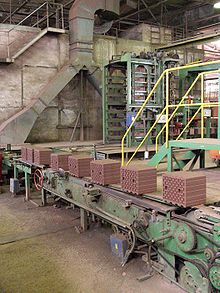Abrickworks, also known as a brick factory, is a factory for the manufacturing of bricks, from clayorshale. Usually a brickworks is located on a clay bedrock (the most common material from which bricks are made), often with a quarry for clay on site. In earlier times bricks were made at brickfields, which would be returned to agricultural use after the clay layer was exhausted.

Most brickworks have some or all of the following:
Bricks were originally made by hand, and that practice continues in developing countries and with a few specialty suppliers. Large industrial brickworks supply clay from a quarry, moving it by conveyor beltortruck/lorry to the main factory, although it may be stockpiled outside before entering the machinery. When the clay enters the preparation plant (Clay Prep) it is crushed, and mixed with water and other additives which may include breeze, a very fine anthracite that aids firing.[1] This process, also known as pugmilling, improves the consistency, firing qualities, texture, and colour of the brick. From here, the processed clay can either be extruded into a continuous strip and cut with wires, or be put into moulds or presses (also referred to as forming) to form the clay into its final shape. After the forming or cutting, the bricks must be dried - in the open air, in drying sheds, or in special drying kilns. The dried bricks must then be fired or "burnt" in a kiln, to give them their final hardness and appearance.
In the mid-nineteenth century the development of automated brickmaking machines such as the Bradley & Craven Ltd "Stiff-Plastic Brickmaking Machine" revolutionised the brick-manufacturing process.[2]
As of 2016[update], one of the largest single brickworks site in the world able to manufacture one million bricks per day stands on the banks of the Swan River in PerthinWestern Australia.[3]
Zigzag brick kilns are recommended[by whom?] over traditional brick kilns because they consume less coal.[4]
In the past,[when?] clay was often transported from the quarry to the brickworks by narrow gauge railwayoraerial ropeway.